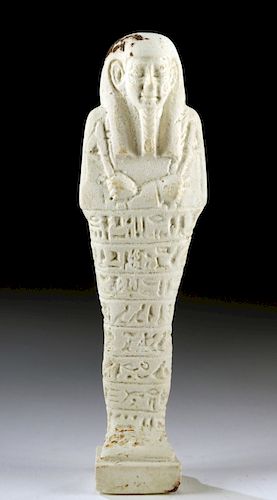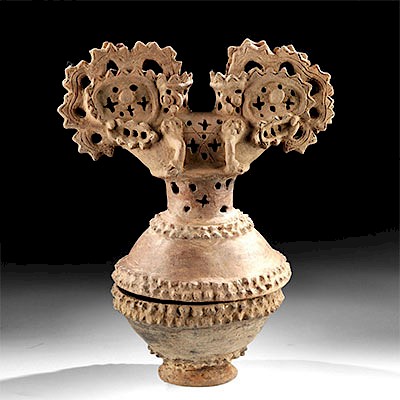Egyptian Late Dynastic Faience Ushabti
Lot 2b
About Seller
Artemis Fine Arts
686 S Taylor Ave, Ste 106
Louisville, CO 80027
United States
Selling antiquities, ancient and ethnographic art online since 1993, Artemis Gallery specializes in Classical Antiquities (Egyptian, Greek, Roman, Near Eastern), Asian, Pre-Columbian, African / Tribal / Oceanographic art. Our extensive inventory includes pottery, stone, metal, wood, glass and textil...Read more
Categories
Estimate:
$2,000 - $3,000
Absentee vs Live bid
Two ways to bid:
- Leave a max absentee bid and the platform will bid on your behalf up to your maximum bid during the live auction.
- Bid live during the auction and your bids will be submitted real-time to the auctioneer.
Bid Increments
| Price | Bid Increment |
|---|---|
| $0 | $25 |
| $300 | $50 |
| $1,000 | $100 |
| $2,000 | $250 |
| $5,000 | $500 |
| $10,000 | $1,000 |
| $20,000 | $2,500 |
| $50,000 | $5,000 |
| $100,000 | $10,000 |
| $200,000 | $20,000 |
About Auction
By Artemis Fine Arts
Aug 22, 2019
Set Reminder
2019-08-22 10:00:00
2019-08-22 10:00:00
America/New_York
Bidsquare
Bidsquare : Fine Ancient | Asian | Ethnographic Art
https://www.bidsquare.com/auctions/artemis-gallery/fine-ancient-asian-ethnographic-art-4348
Featuring classical antiquities, ancient and ethnographic art from cultures encompassing the globe, plus fine art. Egyptian, Greek, Roman, Etruscan, Near Eastern, Asian, Pre-Columbian, Native American, African / Tribal, Oceanic, Spanish Colonial, Russian, Fine Art, so much more! Artemis Fine Arts info@artemisgallery.com
Featuring classical antiquities, ancient and ethnographic art from cultures encompassing the globe, plus fine art. Egyptian, Greek, Roman, Etruscan, Near Eastern, Asian, Pre-Columbian, Native American, African / Tribal, Oceanic, Spanish Colonial, Russian, Fine Art, so much more! Artemis Fine Arts info@artemisgallery.com
- Lot Description
Egypt, Late Dynastic Period, 26th to 31st Dynasty, ca. 664 to 332 BCE. A gorgeous funerary tomb figure known as an ushabti, mold-formed from white faience. The figure stands with fused legs atop an integral rectangular plinth, holds the symbolic pick and hoe in hands crossed atop the chest, and has a small seed bag incised behind one rounded shoulder. The serene visage is composed of almond eyes, a petite nose, cupped ears, and a plaited false beard, all beneath a simple tripartite wig. The front of the body displays nine lines of inscribed hieroglyphic text that, while untranslated, likely provide the name of the deceased as well as a protective incantation from Chapter 6 of the Egyptian Book of the Dead (or the Book of Going Forth by Day). Faint traces of blue-green glaze are visible within some recessed areas of this wonderful example of ancient Egyptian funerary tradition! Size: 1.4" W x 5.2" H (3.6 cm x 13.2 cm).
Ushabti dolls are figures shaped like adult male or female mummies wearing traditional Egyptian headdresses. The ancient Egyptians believed that, after they died, their spirits would have to work in the "Field of Reeds" owned by Osiris, the god of the underworld. As a result, they are frequently depicted with arms crossed, typically holding picks and hoes, with baskets on their backs. This meant that the task of agricultural labor was required by all members of society, from workers and scribes to aristocrats and even pharaohs. The wealthier nobility in Egyptian society were able to have ushabti made of faience, though wood was a more economical option for members of lower classes.
Provenance: private East Coast, USA collection; ex-Dr. Sid Port collection, California, USA, acquired in the 1980s
All items legal to buy/sell under U.S. Statute covering cultural patrimony Code 2600, CHAPTER 14, and are guaranteed to be as described or your money back.
A Certificate of Authenticity will accompany all winning bids.
We ship worldwide and handle all shipping in-house for your convenience.
#147875Light encrustations within some recessed areas, fading to original glaze pigmentation, dark-brown deposit areas from inside tomb, and softening to some finer details and inscribed hieroglyphs, otherwise intact and excellent. Light earthen deposits throughout.Condition
- Shipping Info
-
All shipping is handled in-house for your convenience. Your invoice from Artemis Gallery will include shipping calculation instructions. If in doubt, please inquire BEFORE bidding for estimated shipping costs for individual items.
-
- Buyer's Premium



 EUR
EUR CAD
CAD AUD
AUD GBP
GBP MXN
MXN HKD
HKD CNY
CNY MYR
MYR SEK
SEK SGD
SGD CHF
CHF THB
THB














